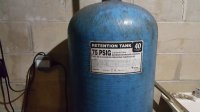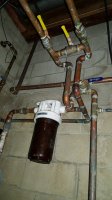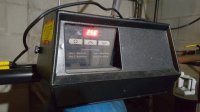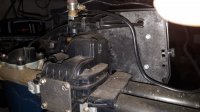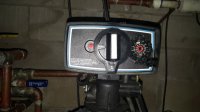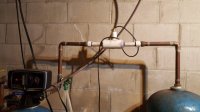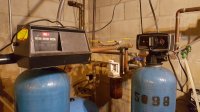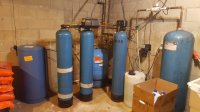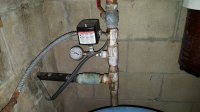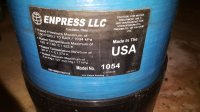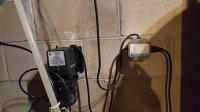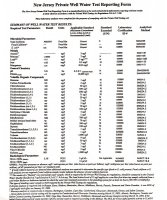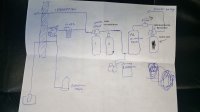Hi everyone. First time posting here and hoping to get some advise from the experts on well water treatment options.
I apologize in advance for the lengthy post but I figured that if I'm gonna take someone's valuable time I should at least present all the facts in order to make their answer more objective and minimize the effort on their part.
I also hope for this post to serve as a complete guide to the next person with similar issues.
I will summarize at the end below the red heading for brevity ...scroll down V
Location: Marlboro NJ. We are on a hill and street level is about 150 ft below the house Well is 315 ft deep drilled in 1989. We are surrounded by some farmland, very little industrial and overall a suburban community setting. 4 people in my family, two little kids that leave the water on and wife that takes half hour long showers and uses the laundry daily. I use untreated water for some of the irrigation on this 5 acre property
We bought this house around 2015 and this is our first house with well water. We did the necessary testing and had the system checked. I noticed orange stains in toilets and sinks but we where told system was functional and might need adjustment. I was also told it was a good system that I should keep. ( I liked the house so I went with it)
I was also told that the system had been serviced regularly and media in the tanks is less than 5 years old.
We did a water test as part of the purchase and then another one about 1.5 years later. both came out the same.
Some of the water test results are as follows: ( I did not include any results with negligible value)
I believe the values are expressed in Micro-grams/liter or ppm
Mercury <.0002
Lead <1.0
Iron <.03
Manganese <.01
PH 7.25
Nitrate <.3
Gross alpha 2.19 pCi/l
water treatment system consists of the following components:
315 ft deep well -Goulds 10gs15 1.5hp 230 volt pump, pressure switch set at ( I think) 70/40, then going through a sentiment filter (I think this is useless because it clogs immediately and has brown and some black and/or colorless slimy stuff inside and bad sewage smell.) I clean it periodically. This was bypassed when we first moved in
It is followed by a pressure tank (I think 40 gallon), then to a
Salt container with twin 10x54 tanks controlled by a Fleck 5600 valve.
Then we have a chlorine injection system with a Steiner pump and a 75 gallon retention tank. (Not sure if this is for bacteria treatment or an oxidation step to remove the iron and magnesium, or both)
This is followed by a 10x54 carbon tank (I guess to remove the chlorine) and finally this goes to the house.
I will try to post pictures on next post but not sure if I can do that as a new member.
The water feel was a shock initially as I did not have experience with "soft" water before _ it added time to my showers as Im trying to wash away the oily/silky residue_ but I researched it and I guess I accepted it.
I immediately noticed the bad egg/sulfur smell on the first morning here but after talking to neighbors and friends I decided it wasn't harmful. (we use a cooler for drinking water)
A few months later after we settled in somewhat I decided to fix the nuisance smell and the staining. I also noticed some other things and searched on the internet for advice. I looked in the toilet tanks and saw some orange settlement but not much. Sometimes I notice a white/clear film if I put the water in a pot to boil it. I also see white foam come out of the spigot on the garden hose spray which goes away after a while.
I brought in several water treatment companies that I paid for consultation and did not like the explanations or absence of explanations or wrong suggestions or the overall absence of attention to detail and it turns out everyone was suggesting what they where selling. I don't blame them but I was bothered by the fact that I would have to depend on them if something were to break or operate out of spec and so I decided to study the system so I can at least make an informed decision in the event of a failure.
I then proceeded to put the inline filter back on line and I clean it every couple of months and change it every six months. I also shortened the time between regeneration on the softener and the carbon tank. This alleviated the orange stains (not sure which action made the difference). A couple of months later I noticed a grey ring around the toilet bowls where the water comes to rest in the tank. This is very hard to clean _I had to use a pumice stone_. I noticed that my salt was being consumed faster (I use about one pallet a year now) Finally the fleck valve started to leak a little and I can see brown water on the shaft that connects to the piston. My assessment is that the piston is bad and this is costly and labor intensive to replace so I started looking to replace the whole valve. THIS IS WHERE IT ALL TOOK A TURN. I brought in a local company who said the grey ring on the toilets was most likely the carbon leaching out from the carbon tank due to deterioration from the chlorine, they said the media on all tanks is probably too old and that the valve repair would be $600.00. The media on all tanks should be replaced at a cost of $1800.00 (3 tanks x 600)
They said technology has changed significantly and my system was outdated. They recommended the EVOLVE EVR TWIN TANK SOFTENER with a built in chlorine generator along with a service contract.
This would be a $7,000.00 installation plus the yearly service contract.
It looks like a good system but its only sold through dealers and I refuse to be a slave to a proprietary system without a warranty unless I take the service contract. It is also very expensive and I cant afford it at the moment. Or ever
It made sense to look for a whole new system and so this is where I fell in the "rabbit hole" of endless research and opinions.
In the process of looking I decided that the DIY option would be best. I can handle the installation, I understand chemistry and physics and have an engineering background. I have tools, I have a proven record of DIY and this choice forces me to learn the things that are important to me and my family and allows for flexibility, and so here I am.
It looks like I have 4-5 options
-Air injection system as a pre-filter and repair the rest then maybe do away with the chlorine setup except that this guy at "uswatersystemsdotcom" says it doesnt work 100% unless a lot of time is spent on disassembling and cleaning often cost aprox $800.00 plus replace media and valve
-peroxide injection except for the additional initial cost and cost for peroxide and the maintenance involved cost aprox $3,500.00
-Ozone injection with an ozone generator built in (haven't researched enough)???
- keep existing format/style/technology and purchase a twin tank with a fleck 9100sxt and new media as a package (Fleck WS-96k-91SXT 9100SXT Dual Tank Water Softener 96k, 96,000 Grain with The Digital 9100 sxt Valve, Almond Or Black) cost $1600.00
and add a brand new Fleck 2510 SXT Backwashing Catalytic Carbon Filter $899.00 essentially I would be keeping my existing chlorine injection system.
- Buy the media (I will need to ask what kind) and replace it myself and then either replace or repair existing valve, or upgrade to a better valve.
I will summarize below for clarity.
choices:
1. keep system and repair or upgrade valve / replace media
2. Air injection: remove chlorine, repair or upgrade valve / replace media
3. Ozone generator: Keep system repair/replace and add ozone instead of chlorine
4. Peroxide injection: remove chlorine repair or upgrade valve / replace media
5. Purchase new: twin tank and media with new 9100sxt valve and new carbon filter with 2510sxt valve
Questions:
1. What type of media is best for my situation? (softener for the twin tanks and de-chlorination-carbon)
2. how much do I need for each softener tank and how much carbon?
3. Can you recommend a vendor in my area or online where I can make all the purchases?
4. Is air injection a choice? does it work? is there one that needs less maintenance?
5. can a evolve EVR system be purchased direct? Is it a good choice? (I guess I like the chlorine generator and the "regeneration as needed" feature)
6. is Ozone a choice? Im not sure I can justify the cost vs benefit and doubt it could work as reliably (ozone production might be slow!)
7. should I buy a twin vortex type of tank where the water enters at the bottom? it makes sense to me that it would work better. can you recommend one?
8. Do you drink the water that comes out of any of these processes or use RO for that purpose? All my neighbors say the water is good to drink as is, as long as it doesn't smell.
9. Is there any new technology that I haven't explored yet?
10. What would you do in this situation for your own house with a budget of $3,000.00 or so?
I really appreciate the time you took to read this and await your advice
Thank you in advance
Spiro
I apologize in advance for the lengthy post but I figured that if I'm gonna take someone's valuable time I should at least present all the facts in order to make their answer more objective and minimize the effort on their part.
I also hope for this post to serve as a complete guide to the next person with similar issues.
I will summarize at the end below the red heading for brevity ...scroll down V
Location: Marlboro NJ. We are on a hill and street level is about 150 ft below the house Well is 315 ft deep drilled in 1989. We are surrounded by some farmland, very little industrial and overall a suburban community setting. 4 people in my family, two little kids that leave the water on and wife that takes half hour long showers and uses the laundry daily. I use untreated water for some of the irrigation on this 5 acre property
We bought this house around 2015 and this is our first house with well water. We did the necessary testing and had the system checked. I noticed orange stains in toilets and sinks but we where told system was functional and might need adjustment. I was also told it was a good system that I should keep. ( I liked the house so I went with it)
I was also told that the system had been serviced regularly and media in the tanks is less than 5 years old.
We did a water test as part of the purchase and then another one about 1.5 years later. both came out the same.
Some of the water test results are as follows: ( I did not include any results with negligible value)
I believe the values are expressed in Micro-grams/liter or ppm
Mercury <.0002
Lead <1.0
Iron <.03
Manganese <.01
PH 7.25
Nitrate <.3
Gross alpha 2.19 pCi/l
water treatment system consists of the following components:
315 ft deep well -Goulds 10gs15 1.5hp 230 volt pump, pressure switch set at ( I think) 70/40, then going through a sentiment filter (I think this is useless because it clogs immediately and has brown and some black and/or colorless slimy stuff inside and bad sewage smell.) I clean it periodically. This was bypassed when we first moved in
It is followed by a pressure tank (I think 40 gallon), then to a
Salt container with twin 10x54 tanks controlled by a Fleck 5600 valve.
Then we have a chlorine injection system with a Steiner pump and a 75 gallon retention tank. (Not sure if this is for bacteria treatment or an oxidation step to remove the iron and magnesium, or both)
This is followed by a 10x54 carbon tank (I guess to remove the chlorine) and finally this goes to the house.
I will try to post pictures on next post but not sure if I can do that as a new member.
The water feel was a shock initially as I did not have experience with "soft" water before _ it added time to my showers as Im trying to wash away the oily/silky residue_ but I researched it and I guess I accepted it.
I immediately noticed the bad egg/sulfur smell on the first morning here but after talking to neighbors and friends I decided it wasn't harmful. (we use a cooler for drinking water)
A few months later after we settled in somewhat I decided to fix the nuisance smell and the staining. I also noticed some other things and searched on the internet for advice. I looked in the toilet tanks and saw some orange settlement but not much. Sometimes I notice a white/clear film if I put the water in a pot to boil it. I also see white foam come out of the spigot on the garden hose spray which goes away after a while.
I brought in several water treatment companies that I paid for consultation and did not like the explanations or absence of explanations or wrong suggestions or the overall absence of attention to detail and it turns out everyone was suggesting what they where selling. I don't blame them but I was bothered by the fact that I would have to depend on them if something were to break or operate out of spec and so I decided to study the system so I can at least make an informed decision in the event of a failure.
I then proceeded to put the inline filter back on line and I clean it every couple of months and change it every six months. I also shortened the time between regeneration on the softener and the carbon tank. This alleviated the orange stains (not sure which action made the difference). A couple of months later I noticed a grey ring around the toilet bowls where the water comes to rest in the tank. This is very hard to clean _I had to use a pumice stone_. I noticed that my salt was being consumed faster (I use about one pallet a year now) Finally the fleck valve started to leak a little and I can see brown water on the shaft that connects to the piston. My assessment is that the piston is bad and this is costly and labor intensive to replace so I started looking to replace the whole valve. THIS IS WHERE IT ALL TOOK A TURN. I brought in a local company who said the grey ring on the toilets was most likely the carbon leaching out from the carbon tank due to deterioration from the chlorine, they said the media on all tanks is probably too old and that the valve repair would be $600.00. The media on all tanks should be replaced at a cost of $1800.00 (3 tanks x 600)
They said technology has changed significantly and my system was outdated. They recommended the EVOLVE EVR TWIN TANK SOFTENER with a built in chlorine generator along with a service contract.
This would be a $7,000.00 installation plus the yearly service contract.
It looks like a good system but its only sold through dealers and I refuse to be a slave to a proprietary system without a warranty unless I take the service contract. It is also very expensive and I cant afford it at the moment. Or ever
It made sense to look for a whole new system and so this is where I fell in the "rabbit hole" of endless research and opinions.
In the process of looking I decided that the DIY option would be best. I can handle the installation, I understand chemistry and physics and have an engineering background. I have tools, I have a proven record of DIY and this choice forces me to learn the things that are important to me and my family and allows for flexibility, and so here I am.
It looks like I have 4-5 options
-Air injection system as a pre-filter and repair the rest then maybe do away with the chlorine setup except that this guy at "uswatersystemsdotcom" says it doesnt work 100% unless a lot of time is spent on disassembling and cleaning often cost aprox $800.00 plus replace media and valve
-peroxide injection except for the additional initial cost and cost for peroxide and the maintenance involved cost aprox $3,500.00
-Ozone injection with an ozone generator built in (haven't researched enough)???
- keep existing format/style/technology and purchase a twin tank with a fleck 9100sxt and new media as a package (Fleck WS-96k-91SXT 9100SXT Dual Tank Water Softener 96k, 96,000 Grain with The Digital 9100 sxt Valve, Almond Or Black) cost $1600.00
and add a brand new Fleck 2510 SXT Backwashing Catalytic Carbon Filter $899.00 essentially I would be keeping my existing chlorine injection system.
- Buy the media (I will need to ask what kind) and replace it myself and then either replace or repair existing valve, or upgrade to a better valve.
I will summarize below for clarity.
Existing old fleck 5600 system with chlorine injection valve leaking all media needs replacing
water test
Mercury <.0002
Lead <1.0
Iron <.03
Manganese <.01
PH 7.25
Nitrate <.3
Gross alpha 2.19 pCi/l
water test
Mercury <.0002
Lead <1.0
Iron <.03
Manganese <.01
PH 7.25
Nitrate <.3
Gross alpha 2.19 pCi/l
choices:
1. keep system and repair or upgrade valve / replace media
2. Air injection: remove chlorine, repair or upgrade valve / replace media
3. Ozone generator: Keep system repair/replace and add ozone instead of chlorine
4. Peroxide injection: remove chlorine repair or upgrade valve / replace media
5. Purchase new: twin tank and media with new 9100sxt valve and new carbon filter with 2510sxt valve
Questions:
1. What type of media is best for my situation? (softener for the twin tanks and de-chlorination-carbon)
2. how much do I need for each softener tank and how much carbon?
3. Can you recommend a vendor in my area or online where I can make all the purchases?
4. Is air injection a choice? does it work? is there one that needs less maintenance?
5. can a evolve EVR system be purchased direct? Is it a good choice? (I guess I like the chlorine generator and the "regeneration as needed" feature)
6. is Ozone a choice? Im not sure I can justify the cost vs benefit and doubt it could work as reliably (ozone production might be slow!)
7. should I buy a twin vortex type of tank where the water enters at the bottom? it makes sense to me that it would work better. can you recommend one?
8. Do you drink the water that comes out of any of these processes or use RO for that purpose? All my neighbors say the water is good to drink as is, as long as it doesn't smell.
9. Is there any new technology that I haven't explored yet?
10. What would you do in this situation for your own house with a budget of $3,000.00 or so?
I really appreciate the time you took to read this and await your advice
Thank you in advance
Spiro

